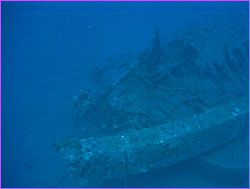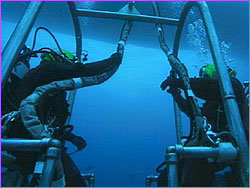
|

|
Back to Behind the Scenes For the underwater portion of "Lincoln's Secret Weapon," we needed a camera system that would work well at 230 feet and would have excellent color, contrast, and depth of field in situations of low natural light. So I brought a Sony wide-screen digital Betacam with a Fujinon 4.8mm wide-angle lens, which we enclosed in a special underwater housing developed by Vince Pace of Pace Technologies (Sun Valley, Calif.). We prepped the underwater housing for working at this depth using a special vacuum pump system that enabled us to check the housings for leaks before each dive. In addition, we had several of Pace's 400-watt, battery-powered portable underwater lights, which the lighting divers carried during each dive. Camera One of the reasons the camera worked so well was that it featured an internal microprocessor that enabled me to completely customize the colorimetry and look of the camera for the depth and conditions I was shooting in. One of the shots I had to capture was a wide one of the Monitor under natural lighting conditions. I was able to take the digital camera and electronically dial in colored filters that I would normally use when shooting with a 16mm underwater. In this way, I was able to gain back much of the light I would have lost shooting through filters. The result was wide shots of the ship under low light with all the depth, contrast, and detail I was looking for.
Another advantage of using this digital Betacam system for this particular project was the length of record time. If I had chosen to shoot with a film camera underwater, I would have had only about 11 minutes of wreck coverage on each dive. With the digital Betacam, I had up to 40 minutes of recording time on the wreck per dive. If we had used film, I would have missed several important sequences with the Navy divers, several of which occurred during decompression. Although I usually prefer shooting film underwater, when it comes to deep, lower-light, or murky conditions, I will use a digital format like Digibeta, or High Definition. Lighting The lights we used enabled us to illuminate the bow of the Monitor enough to make the fish sparkle and to see color in the coral encrusting the wreck. (This shot opens and closes the film.) The lights also brought out the wreck's many features as well as all the color in the Navy divers' equipment. —D.J. Roller Tour the Monitor | Behind the Scenes Eyewitness to the Battle | Steam Machine | Resources Transcript | Site Map | Lincoln's Secret Weapon Home Editor's Picks | Previous Sites | Join Us/E-mail | TV/Web Schedule | About NOVA Watch NOVAs online | Teachers | Site Map | Shop | Search | To Print PBS Online | NOVA Online | WGBH © | Updated May 2003 |

